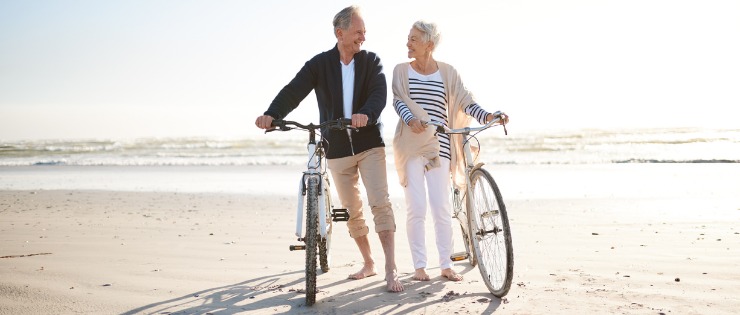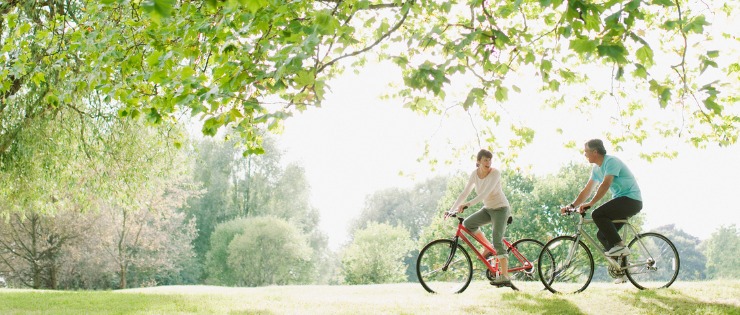
You never forget how to ride a bike. Even if you haven’t cycled since you were in school, it’s not too late to ride again.
A National Participation Survey in 2012 found the number of cyclists in Australia is declining because of urban development that doesn’t support cycling, bike helmet legislation and our ageing population. But age doesn’t need be a barrier to bike riding.
Cycling has many benefits for more mature riders, many you may not have considered. Health benefits including slowing the ageing process, reducing the chance of falls in everyday life, improved mental health and overall improvements in wellbeing.
#1 Cycling Can Boost Your Mental Health
Just like physical health, your mental health can decline with age. Even if you haven’t experienced any mental health issues during your life, your senior years can bring a host of new challenges.
The risk of cognitive degenerative disease increases with age as does boredom and loneliness which can lead to depression and anxiety.
Unless you use a stationary exercise bike in front of the TV, cycling gets you out in the great outdoors. Enjoying a ride outside gives you a dose of vitamin D and fresh air. Sunlight is the only natural way for your body to get vitamin D which helps improve mood and reduces stress levels. Exercise also takes your mind off worries and allows you to de-stress.

Sleep and mental health are closely connected - poor sleep is thought to contribute to psychiatric disorders. Difficulty sleeping is one of the main complaints of seniors. They can have trouble falling asleep and staying asleep for a full night’s rest. Exercising outside in fresh air can improve both the quality and quantity of sleep.
According to the Black Dog Institute, research shows it takes at least eight weeks for exercise to have a significant reduction on depression. Commit to try cycling for two to three months to start enjoying the full benefits.
#2 Boost Your Immune System
Cycling can help your immune system fight off nasty bugs. The thymus organ is responsible for the body’s immune cells (called T Cells). From the age of 20, the thymus shrinks and our immune system declines by 2-3% each year. By middle age, the thymus is down to 15% of its maximum size so the body relies on the antibodies it has gained from fighting germs over the years.
A study by Aging Cell of 125 long distance cyclists aged in their 80s found their immune systems were robust because they were producing as many T cells as someone in their 20s. Physical activity like cycling can help the body flush out bacteria from the lungs and airways which reduces the chance of a cold or flu taking hold. A rise in body temperature while exercising also prevents bacteria from growing and fights infection.
#3 Slow Down the Ageing Process
As we move into our later years, it’s normal to lose muscle mass. Our muscles’ ability to contract reduces due to fat and connective tissue. When seniors stop being active, the rate of muscle loss speeds up and they age faster.
In a study that compared the health of cyclists aged between 55 and 79 to a group of healthy non-cyclists of the same age, the cyclists were healthier. They had preserved muscle mass and strength compared to those that didn’t cycle and had maintained stable levels of body fat with better cholesterol levels. Men in the cyclists group also had higher testosterone levels.
Cycling can increase your lifespan by reducing the risk of chronic disease. In a UK study of 260,000 adults, those that cycled cut their risk of death from all causes by 40% and cut their risk of cancer and heart disease by 45%.
Cycling is also a form of vigorous activity that protects telomere length. Shortened telomere cause ageing and cell death. Regular exercise can save up to nine years of reduced cellular deterioration.
But it can be difficult to keep cycling with age. Degeneration of joints and muscles or balance issues mean seniors have to eventually give up cycling.

A disability and rehabilitation study of people with osteoporosis, knee replacement patients and people with ligament injuries showed their ability to ride a bike reduces by 5% annually. The rate of decline in women is 1.98 times greater for women than it is for men. A high body mass index increases the chance of experiencing pain while riding by 8%.
Safe alternatives are to switch from a regular bike to an electric bike with a built in motor to assist with pedalling. When uneven surfaces and conditions make it dangerous for a senior to ride, they can swap to an indoor stationary bike for some of the continued health benefits.
#4 Reduce Risk and Symptoms of Alzheimer’s Disease
Research shows exercise can delay, if not prevent, Alzheimer’s Disease and dementia. From middle age, people should exercise not only for their physical health but also their mental health.
Exercise can reduce the levels of tau, a protein in the brain linked to Alzheimer’s. Exercise increases blood flow in the memory and processing centre of the brain which can improve attention, planning and organising.
Symptoms of mental health conditions can reduce with exercise. A study showed aerobic exercise improves Alzheimer’s-related changes in the brain. Two years of regular exercise, brain training and healthy eating can boost memory function.
#5 Less Stress on the Joints
For many seniors, running or even walking for long distances is out of the question. Both activities can stress worn-out or injured joints while cycling is an exercise that places very little pressure on most joints. Casual walking can cause forces of three times your body weight across both knees while running can be as much as five and a half times. The more weight you carry, the more stress on your joints.
Swimming is often recommended to people who can’t bear weight while exercising. The water makes the body buoyant and allows the swimmer to exercise bearing little to no weight on injured or stressed joints. But not everyone is a good swimmer or has access to a pool.
Cycling strengthens knee muscles without traumatising the joint. A stronger knee muscle means less chance of injury. However, cycling can cause knee pain in some people. The more weight and uphill pedalling you do, the greater force placed on the knees.
Knee replacement patients often cycle a stationary bike a week or two after surgery to improve mobility in their new knee. In the early days it isn’t possible to pedal a full circle so the patient will pedal forward as far forward as possible, hold the position for a few seconds before pedalling back and repeating. Once the knee can bend to 90 degrees, they can pedal all the way round.
Experts recommend that people with osteoporosis cycle because it moves the knee through a range of motions and strengthens surrounding muscles. Weight bearing exercises like jogging can injure the spine, hips, knees and ankles.
#6 Improved Balance Reduces the Risk of Falls
The World Health Organisation (WHO) estimates 28-35% of people over the age of 65 suffer from a fall each year. Seniors have an increased risk of falling because of:
- Health conditions such as heart disease
- Impairments like vision loss
- Other illnesses that affect balance
People can fall at any age, but muscle weakness and limited joint movement increases the risk of slips, falls and trips in seniors. In older people, the injuries sustained from a fall are more serious. Seniors have thinner skin which bruises and cuts easily, and bones are more likely to fracture and break, particularly if they have osteoporosis.
Cycling is an ideal exercise for improving balance. Keeping yourself and your bike upright helps with balance throughout the day.
Balance requires the brain to receive messages from muscles, joints, eyes and ears and respond. But the link between the brain and muscles breaks down if muscles aren’t being used to their potential. Riding a bike is excellent practice for your brain to respond quickly to changes in surroundings. Coordination and posture also improves from using a bike, both of which help with balance.
One of the main benefits of bike riding is strengthening muscles. Riding increases leg, glute and core muscles which all help later in life to get up from the chair and to stop ourselves from falling over. Keeping muscles and bones strong help with movement and flexibility.

#7 Meet New People & Socialise More
Cycling is a great social activity. Many people ride with partners or as part of organised groups.
One of the most challenging problems for older people is loneliness. Once people leave the workforce, they lose the group of friends and acquaintances they communicated with daily. Once the work connection is gone, it can lead to mental health issues caused by boredom and loneliness in seniors. Cycling can give you a reason to leave the house and meet other people who have a common interest.

Cycling Australia has links to cycling groups in every state and territory. Some states have over 60 cycling groups. Joining a group gives you encouragement, allows you to set goals and work together as a group to achieve the targets.
Group support provides feelings of well-being and rides often finish at a café so riders can finish with a coffee and chat with fellow riders. Cycling Australia has a program called She Rides to encourage women to take up the sport and connect with other female riders through state events.
Keep Your Cycling Safe
The right equipment can make all the difference to stay safe on your bike.
A fall from a bike can be dangerous at any age, but it’s riskier for seniors. Always wear a helmet, sturdy shoes and light coloured or high-vis clothing so motorists can see you.
Gloves, long sleeved tops and full length pants can offer your skin some protection if you have a fall.
If you are buying a new bike, ask to test ride a few to see what type suits you better. Racing bikes require you to sit hunched over compared to others that allow you to sit more upright. A good quality bike seat should give you a more comfortable ride.
Like any new physical activity, it’s best to ease into it. Start slow and don’t ask too much from your body, especially if you haven’t been exercising regularly.
If you are thinking of taking up cycling and you haven’t exercised in a while, consult your GP or an exercise physiologist for advice first.